I started off with a quick flight from Guangzhou to Xian on May 2nd, after the May 1st holiday rush prevented me from taking the (much cheaper) train. On the way into town from Xian airport, I rode past the mausoleum of the Western Han emperor Jingdi, whose son, Wudi, would open up Central Asian trade with China. The tomb, like all 9 Han tombs north and west of Xian, is a huge earth mound almost the size of an Egyptian pyramid, surrounded by smaller mounds for sons and wives and prime ministers. Around the tomb, rather like the famous Terracotta Army found around the tomb of the first Chinese emperor Qing Shihuangdi, were found thousands of terracotta model soldiers. These ones, unlike the life-size ones for Shihuangdi, are half-sized and, oddly, naked, their clothes having rotted off over the centuries. As well, their arms were wooden and have turned to sawdust over the years, and the overall effect is a bit comical. There are lots of model horses as well, and looking at them, they're awfully small, squat pony-like creatures. It was the Chinese need for bigger, faster horses that was one motivation for the Han emperors to open trade with the Ferghana and Ili valleys in Central Asia; their enemies, the Huns, always had an advantage over the Chinese because of their superior horses. This tomb has only recently been opened to the public, and should in time become as famous as the Terracotta Army.
 |
| Setting off from the Great Wild Goose Pagoda, Xian, with Xuanzang's statue |
Full of historical musings, I continued into Xian. The modern city is an unlovely industrial smog-choked sprawl, but there are hints of the new China here and there in new suburban stand-alone houses straight out of a North American subdivision, and the spanking new Audi cars racing along the broad highway into town. In a vignette of the new China, a nouveaux-riche Chinese man was washing his new Audi a few metres from where a penniless peasant, his few belongings forming a pillow for his head, was sleeping on his first day in the big city where he hoped to make his fortune. I fetched up in the foreigner ghetto hotel The Flats of Renmin and turned in.
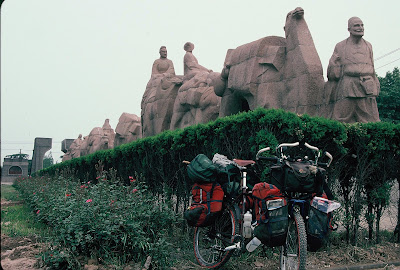 |
| Tacky concrete Silk Road monument on the way out of Xian |
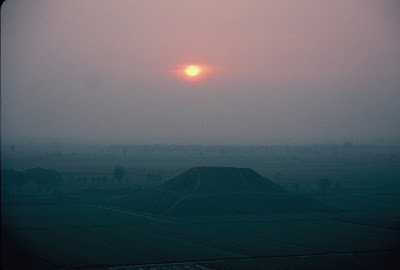 |
| Smoggy sunset over the Mao Ling, the tomb of the Han emperor Wudi |
The next day, after visiting a few sights around town such as the monument to one of my favourite travellers, the monk Xuan Zang, I set out on my bike for Europe. I didn't get too far, as I stopped 25 km down the road in Xianyang, the Chinese capital under the first emperor Qin Shihuangdi. The museum had another terracotta army on display, 3000 one-third life size warriors from the tomb of an unidentified noble; model soldiers were obviously all the rage among dead Chinese 2200 years ago. Then it was off into the countryside to another Han emperor's tomb, this time that of the emperor Wudi, the long-reigning (138-87 BC) ruler who opened up the Silk Road. It was another grassy mound up which I climbed, along with a few dozen Chinese tourists, to enjoy the view amidst the discarded plastic bottles, ice cream wrappers and plastic bags that adorned the top. Again the view was over subsidiary tombs and, distantly, those of other emperors. After the tourists had zipped back to Xian, I pitched my tent among a small forest, planted to cover archaeological digging around the tomb, and spent the night imbibing historical ambience.
The next day I continued along the tourist trail west of Xian. I left behind the Western Han tombs and moved into the Tang dynasty (7th-10th centuries AD), in some ways the apex of Chinese power and civilization. I visited the tomb of the emperor Gaozhang, an impressive hilltop tomb with the obligatory huge earthen mound and a processional way of fantastic beasts and statues of subjects bearing gifts. It was rather like an Egyptian pharaoh's tomb, only much less well-known to the outside world. I also looked in at an excavated tomb of the prince Yi De. It was also very Egyptian, like the tombs in Luxor's Valley of the Kings, with a long downward-sloping entrance tunnel adorned with impressive painted frescoes, leading to a mammoth black stone sarcophagus in the tomb chamber. I finished the day at the Doorway Temple, Famen Si, the site of a spectacular find of Buddhist relics and (oddly) tea ceremony implements from the Tang Dynasty. I retired into my hotel to escape the rain and to eat the delicious pork sandwiches that sidewalk vendors were selling outside the temple. Rain and grey skies were to plague me for much of the rest of the ride, depriving me of views and making riding a depressing slog.
 |
| New mosque in Linxia |
 |
| Big church in the Wei River Valley |
From Famen Si I ground up the Wei River valley, through a landscape of soft soil eroded into steep escarpments and full of subterranean houses and barns dug out of the earth. The population in the countryside was largely Muslim, the so-called Hui ethnic minority, distinguished by the white, puffy caps that the women wear, making them all look like bakers. They're ethnically Chinese, but converted to Islam 8 centuries ago under the Mongols, whose armies and administrators were full of Muslims. For all the Muslim villages, though, I didn't see a single mosque or hear any calls to prayer. As a counterpoint to this, I saw a surprising number of Christian churches, most of them big and imposing, and even some tiny Christian shrines and graves in farmer's fields. I don't know when these villagers converted to Christianity: in the 19th and 20th centuries, when Western missionaries were active in China, or much earlier, when Nestorian Christians were prominent in China during the Tang Dynasty. At any rate, it was interesting to see the Silk Road, the route of dissemination of Buddhism, also doing the same for other religions.
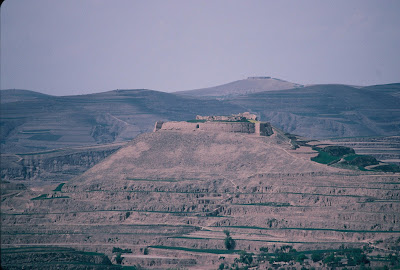 |
| Hilltop fortification in eastern Gansu |
 |
| Gian Buddha statue at Maijishan |
After passing through the gargantuan new industrial city of Baoji (China is full of million-plus cities that no-one outside China has ever heard of), I soldiered on through deep, dramatic gorges that the piddling stream of the Wei River seemed incapable of having carved. I eventually made it to another industrial smog-hole called Tianshui (Heavenly Water, a misnomer for the polluted muddy Wei) where I checked out some Buddhist caves, the Maijishan Grottoes. Billed as "The Fourth-Largest Buddhist Caves in China", the caves were numerous but largely underimpressive. The nicest part about them were the beautiful forested hills in which they were set, the first real forests I'd seen since arriving in China. This phenomenon of carving cave temples into mountains was all the rage throughout the Buddhist world from about the 4th to 10th centuries, with examples in India, Sri Lanka, Tibet and China from this period. The Silk Road sometimes seems to be a road linking one cluster of Buddhist caves with another.
 |
| Scenery in the hill country of eastern Gansu |
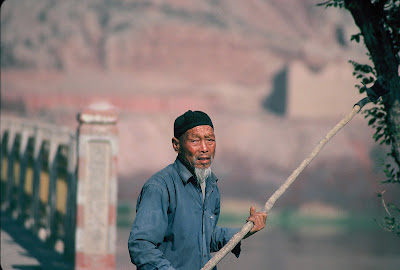 |
| An elderly gentleman pruning trees on the bank of the Yellow River |
From there, I ground on, climbing atop the flat plateaux above the river valley, getting rained on and wondering what I was doing. It was slow going, and it was impossible to camp at night because all available flat land was either under cultivation or under houses. Here and there ruins of ancient forts and castles topped the higher hills. It was astonishing how dense the rural population was; talking to them in my pidgin Chinese left me convinced that a lot of them were dense in other ways as well. The population continued to be largely Muslim, with old men sporting picturesque wispy goatees and 1920s-style round glasses that Elton John might wear. Around Lingxia, I passed through a staunch Muslim heartland full of new space-age mosques and full Taliban beards. I was making a detour around Lanzhou, the most polluted city in China (and hence, probably, the world) to visit a Tibetan monastery, Xiahe, to get a quick fix of Tibet before pressing on into Muslim Central Asia.
 |
| Labrang Monastery prayer wheel |
When I finally got to Xiahe, after several hard days of climbing, I almost wished I hadn't bothered. The city was an unlovely concrete jungle, indistinguishable from any other Chinese city. The Tibetan monastery, Labrang, is one of the Big Six monasteries of the Dalai Lama's Gelugpa sect, and seemed more inhabited and more alive than the ones I'd seen in Lhasa and Shigatse last year, but still seemed to be lacking something. The monastery was flattened during the Cultural Revolution and has no genuinely old buildings; maybe what it was lacking was history. There were more pilgrims prostrating their way around the monastery than I've ever seen anywhere; there must have been 200 monks and civilians measuring their length on the ground as they inchwormed their way around, taking hours to complete the circuit.
 |
| Crossing the Yellow River |
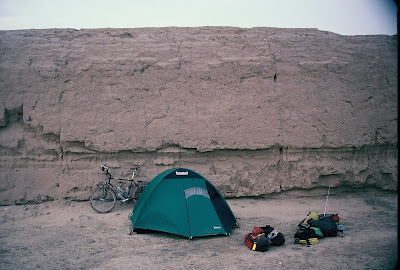 |
| Camped in the wind shadow of the Great Wall of China |
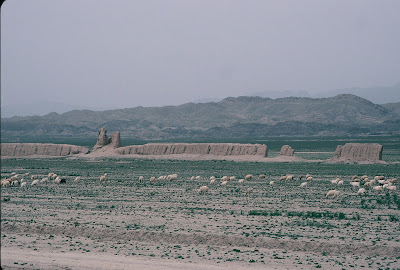 |
| Sheep grazing beside the Great Wall, western Gansu |
After backtracking to Linxia, I had more short, steep climbs through precipitous valleys to get to the Yellow River, the cradle of Chinese civilization. I crossed it three times, cutting over some S bends, and then finally left it behind on May 16th. I followed a tributary upstream, crossed a high, barren pass that reminded me of Tibet, and entered, geographically, Central Asia. At the top of the pass I met up with the Great Wall of China for the first time and picnicked atop it, looking at the old earth wall and parallel ditches that carved their way arrow straight across the mountains. From then on, until here, I've been parallelling the Wall, occasionally in sight of it, and frequently in sight of forts and of ancient beacon towers for transmitting news of attacks quickly along the Wall. I even camped right next to the Wall one night, using it to hide my tent from curious passersby on the road. Here at Dunhuang I'm finally turning away from the Wall, leaving behind the 2100-year-old towers that look no older than the mud-brick villages that dot the countryside.
 |
| Old Ming or Qing-era watchtower, a westward extension of the Great Wall |
 |
| Stately elderly gentleman on his bicycle |
Once I got over that pass, I started to make better time. The road, following the old Silk Road, runs to the north of a long range of snow-capped 5000-metre mountains and to the south of the barren wastes of the Gobi Desert. There was one more high pass to cross this, at the foot of which a huge herd of horses was blocking the expressway. Near the top of the pass I ran into Terry and Tim, a pair of American cyclists who had ridden from Switzerland to China. (Check out Tim's web site by clicking here) The road runs from irrigated oasis to irrigated oasis, so food and water haven't been a problem at all. If the sky had been clear, I'm sure I would have seen spectacular mountain scenery, but as it was, it continued grey and I encountered far more rain than you might expect in a desert.I can add the Gobi to the Sahara, the Atacama and the Australian deserts as places I have brought rain to. I should hire myself out as an itinerant rain god to drought-stricken places like Ethiopia and Zimbabwe.
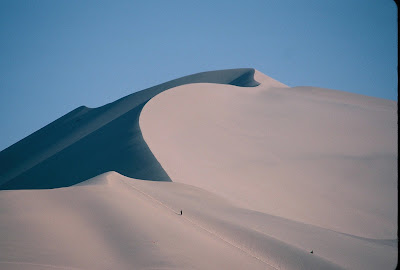 |
| Giant dune (and tiny person) near Dunhuang |
 |
| The western end of the Great Wall, outside Jiayuguan |
Anyway, lately I've been rolling along flat desert with tailwinds, making an easy 130 or 140 km a day, taking pictures of furry Bactrian camels, camping in the desert and enjoying riding again. I checked out the end of the Ming Dynasty Great Wall in Jiayuguan, then zipped here to see the biggest Buddhist cave complex in China and, probably, the world. It's a wonderful place; I just wish the Chinese authorities would make it easier actually to see the caves. They're all kept locked, and to see them you have to join a (Chinese-language) tour. They hustle you in and out as quickly as possible, barely giving you enough time to see the statues and the intricate paintings that cover the walls and ceilings. The phrase of the day was "Quickly!! Let's go!! Come outside now!!" My tour visited only 5 of the 492 caves, so I hung around and joined a string of other tours in order to see other caves, eventually tallying 20. I got chased out of several "special caves" not open to any old visitor, only to special, expensive tours. For US$10, a fifth of the average monthly wage, you don't get much for your money. It seems to me that, given that 1000 or so visitors come to the caves every day, each paying $10, they could open dozens of caves, hire attendants to guard each cave, and let people wander in and out at will, spending as much or as little time in each as they wished. But perhaps I'm thinking too much from a libertarian, Western, decadent, capitalist, imperialist, bourgeois point of view.
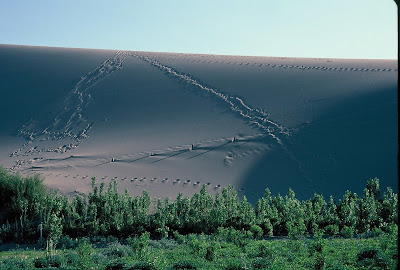 |
| Footsteps on the dunes of Dunhuang |
The plan now is to ride to Urumqi, 1000 km west of here, to pick up my Kazakh visa, then 600 km further to the Kazakh border. After the expense and hassle of getting a Kazakh visa, I will end up only cutting across a tiny corner of Kazakhstan to get to Kyrgyzstan and meet up with Audie and Saakje (my sisters) and Audie's partner Serge tp do some hiking and mountain climbing. Then I hope to cycle through Uzbekistan, visiting the old Islamic cities of Samarkand, Bukhara and Khiva, before cutting across Turkmenistan at its narrowest point to get to Iran and, finally, Turkey. It all depends a bit on getting visas arranged (the 'Stans are a Soviet nightmare in terms of visas), on not running out of funds and on there not being unrest or US bombing along my route. Things are a bit dicey in Kyrgyzstan at the moment, according to the BBC World Service, with big anti-government protests blocking the main road. I hope it all clears up by the time I get there.
Until the next installment from the Silk Road,
Zai Qian (Goodbye)
Graydon
Riding Day No.
| Date |
Distance
from Xian airport (km)
|
Daily
Distance
(km)
|
Cycling
Time
(hours)
|
Average
Speed
(km/h)
| Daily Destination |
| 1 | 5/2 | 52.8 | 52.8 | 3:17 | 16.0 | Xian |
2
| 5/3 |
127.9
|
75.1
|
4:43
|
15.9
|
Mao Ling
|
3
| 5/4 | 219.7 |
91.8
|
5:46
|
15.9
|
Famen Si
|
4
| 5/5 | 342.3 |
122.6
|
8:06
|
15.1
|
Past Baoji
|
5
| 5/6 | 438.6 |
96.3
|
6:15
|
15.4
|
Before Tianshui
|
6
| 5/7 |
544.5
|
105.9
|
6:27
|
16.4
|
Beidao
|
7
| 5/8 |
647.9
|
103.4
|
8:14
|
12.5
|
Panzhe
|
8
| 5/9 |
720.4
|
72.5
|
5:51
|
12.3
|
Longxi
|
9
| 5/10 |
845.1
|
124.7
|
7:42
|
16.2
|
Lindao
|
10
| 5/11 | 946.2 | 101.1 | 5:52 | 17.2 | Linxia |
11
| 5/12 | 1055.4 | 109.2 | 8:21 | 13.0 | Xiahe |
12
| 5/14 | 1191.7 | 136.3 | 8:36 | 15.8 | Dong Shen |
13
| 5/15 | 1264.0 | 72.3 | 5:56 | 12.2 | Between Yongjing and Hekou |
14
| 5/16 | 1397.6 | 133.6 | 8:11 | 16.3 | Tianzhu |
15
| 5/17 | 1529.2 | 131.6 | 7:52 | 16.7 | Wuwei turnoff |
16
| 5/18 | 1638.4 | 109.2 | 7:11 | 15.2 | near Shuiquanzi |
17
| 5/19 | 1728.6 | 90.2 | 6:04 | 14.8 | between Shandun and Zhangye |
18
| 5/20 | 1855.5 | 126.9 | 5:42 | 22.2 | Gaotai |
19
| 5/21 | 2022.5 | 167.0 | 8:41 | 19.2 | Jiayuguan |
20
| 5/22 | 2119.3 | 96.8 | 5:46 | 16.8 | 40 km past Jiayuguan |
21
| 5/23 | 2242.3 | 123.0 | 6:14 | 19.7 | outside Yumen Zhen |
22
| 5/24 | 2349.0 | 106.7 | 4:53 | 21.9 | Anxi |
23
| 5/25 | 2467.4 | 118.4 | 5:24 | 21.9 | Dunhuang |
24
| 5/26 | 2535.2 | 67.8 | 3:24 | 19.9 | Dunhuang (day trip to Mogao caves) |